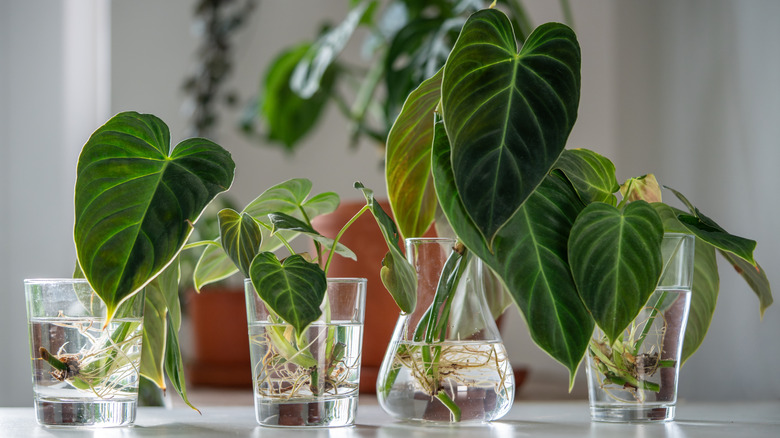Turn Your Propagating Plants Into Flowers For A Prettier Look
Coaxing a leaf or stem cutting into a thriving plant is like magic — or maybe it's more like the best kind of hands-on science lesson. Given time, our trimmings put out roots and are ready to take up residence in the soil. Lots of home gardeners have scads of bottles and jars spouting one lone leaf that's waiting to grow roots. Save space and make the cuttings ever so lovely by bundling them into a flower shape. Bind a cluster of leaves with a rubber band by their stems before placing them in the propagation medium. Leaves radiating out from a common center morph several anemic single leaf stems into a lush blossom that pleases the eye while waiting for roots to emerge.
Leafy plants that generate roots well in just water are ideal for this, but many plants will grow roots in perlite or soil. You can also propagate your plants in sand. Depending on the plant and the medium, you may not even need to bind the cuttings together with a rubber band; both soil and sand may help hold the flower shape in place simply by inserting the leaves' stems directly into the material as a bundle.
The best plants for this purpose
Not every type of plant cutting will do for this aesthetically upgraded propagation method. Ones that root well from stem or leaf cuttings are ideal. Leaf cuttings are best if the leaves' stems are long, as well. Philodendron and pothos can regenerate from stem cuttings. With the ability to remove lower leaves, you're able to customize the length of the stems, making them better for slipping inside a tall vase or jar.
The leaves of hydrangeas, African violet, peperomias, and sinningias are perfect for forming into rosettes. Even sage leaves easily propagate from cuttings. All of these plants reproduce from a leaf in water, perlite, or soil. Since the leaf stems aren't as long as a stem cutting would be, keep an eye on evaporation for water-bound plants to ensure that the short stems' ends consistently reach the liquid rather than hovering above it.
While it's not a bouquet of leaves that's free standing in a container, you can pull off a charming floral look with succulent leaves, as well. These juicy pads are great at taking root when they're placed directly on cactus potting mix or inserted into the soil. Let succulent leaves callus over for 24 hours before arranging them on cactus growing medium. Once they're ready, dip the ends of each leaf in rooting hormone. (Cinnamon can be used as a rooting powder, too.) Gently press the ends of each leaf into the soil at a shallow angle. Place them near enough to each other and in an arrangement that suggests petals of a flower, but don't place them so closely that the leaves touch.
